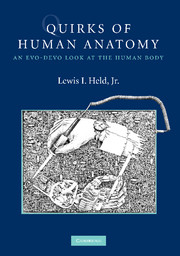Book contents
- Frontmatter
- Contents
- Preface
- CHAPTER 1 BACKGROUND
- CHAPTER 2 SYMMETRY AND ASYMMETRY
- CHAPTER 3 MYSTERIES OF THE MIDLINE
- CHAPTER 4 MERISM AND MODULARITY
- CHAPTER 5 SEXUAL DIMORPHISMS
- CHAPTER 6 SILLY, STUPID, AND DANGEROUS QUIRKS
- CHAPTER 7 MIND AND BRAIN
- EPILOGUE
- APPENDIX: QUIRKS OF HUMAN BEHAVIOR
- References
- Index
CHAPTER 2 - SYMMETRY AND ASYMMETRY
Published online by Cambridge University Press: 05 August 2012
- Frontmatter
- Contents
- Preface
- CHAPTER 1 BACKGROUND
- CHAPTER 2 SYMMETRY AND ASYMMETRY
- CHAPTER 3 MYSTERIES OF THE MIDLINE
- CHAPTER 4 MERISM AND MODULARITY
- CHAPTER 5 SEXUAL DIMORPHISMS
- CHAPTER 6 SILLY, STUPID, AND DANGEROUS QUIRKS
- CHAPTER 7 MIND AND BRAIN
- EPILOGUE
- APPENDIX: QUIRKS OF HUMAN BEHAVIOR
- References
- Index
Summary
Humans look symmetric on the outside but have stark asymmetries on the inside (Fig. 2.1). Thus, we have a spleen on the left but not the right. Our left lung has two lobes, but our right lung has three. Our heart and stomach are shifted left of center, our liver is shifted right of center, and our intestines meander throughout our abdominal cavity with no regard for the midline at all.
Why are we symmetric outside but asymmetric inside?
The paradox of outer symmetry and inner asymmetry actually makes sense from an evolutionary perspective. Our outer shell of bones and muscles has always served a locomotory function [1871]. External symmetry allowed our aquatic ancestors to become streamlined for speed [1672, 1871, 2766], and it has been retained ever since because it is just as useful for walking as it was for swimming [517]. In contrast, the only locomotory restriction on our internal organs has been that their weight be distributed evenly relative to the midline.
If we trace the history of our anatomy back before the fish stage of evolution, we find that the inside of the body used to be as symmetric as the outside [512, 1462]. Fossils of “Urbilaterians”—the earliest animals with bilateral symmetry [195, 1393]—show a digestive tract that ran directly from the mouth to the anus, with no twists or turns along the way [431].
Why did the gut of vertebrates then become asymmetric? Part of the answer concerns size [242, 955, 1238]. The ocean is a fish-eat-fish world, and the bigger you are, the more likely you are to survive (all other factors being equal).
- Type
- Chapter
- Information
- Quirks of Human AnatomyAn Evo-Devo Look at the Human Body, pp. 17 - 32Publisher: Cambridge University PressPrint publication year: 2009
- 1
- Cited by



